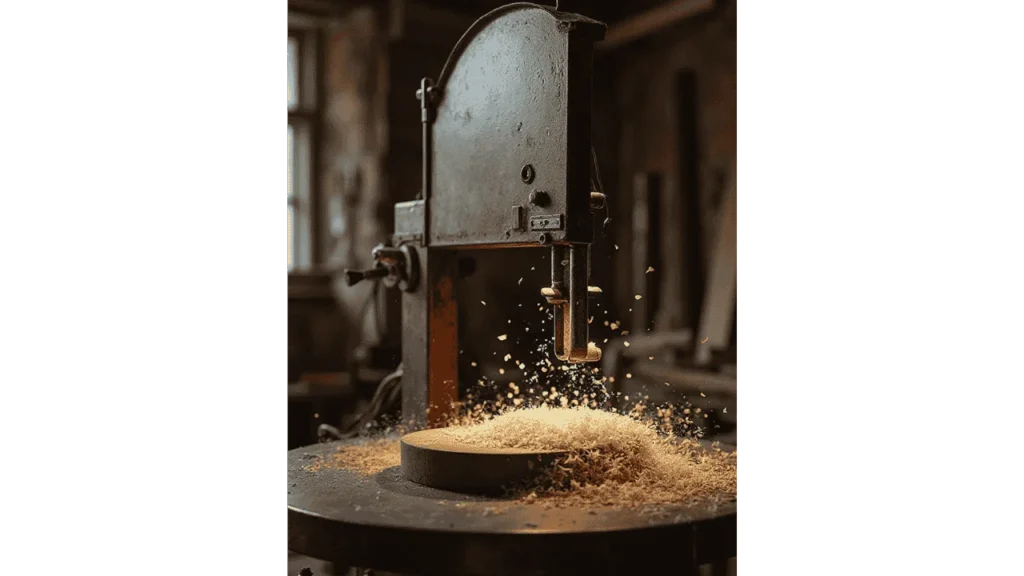A band saw is a power saw featuring a continuous, flexible blade made of toothed metal stretched between two or more wheels. You can use it to cut a wide range of materials including wood, metal, and plastic. Its primary function is to provide precise straight, curved, or irregular cuts, making it one of the most versatile tools in a workshop. From my experience, a band saw is invaluable for both professional woodworking and DIY projects, as it allows you to execute intricate cuts that would be challenging with other saws.

Components of a Band Saw
The blade is a continuous loop of toothed metal that performs the cutting action. Two or more wheels guide and tension the blade to maintain proper alignment during operation. The table is a flat surface where you place the material to be cut, providing stability and control. A powerful motor drives the wheels and the blade, ensuring consistent cutting speed. Blade guides and bearings help maintain blade alignment and smooth operation, while a blade guard covers the blade to prevent accidental contact, improving safety. Understanding these components helps you operate the saw efficiently and safely.
Types of Band Saws
Vertical band saws have the blade running vertically, allowing for intricate cuts and curves, commonly used in woodworking and metalworking. Horizontal band saws run horizontally and are ideal for cutting large, straight pieces of material, often in metal fabrication. Portable band saws are handheld, providing mobility for on-site cutting tasks. Benchtop band saws are compact, designed for small workshops or home use, and allow you to make precise cuts in a limited space.
Common Uses of a Band Saw
You can use a band saw in woodworking for cutting curves, resawing lumber, and creating intricate shapes. In metalworking, it’s effective for cutting pipes, rods, and profiles. Plastic fabrication tasks, like trimming and shaping, are also easily handled by a band saw. In meat processing, it can be used to cut meat into portions accurately.
“A band saw’s versatility across materials and projects makes it a must-have tool for both professionals and hobbyists,” says tool expert Jack Harris.
Additionally, lumber mills use band saws to rip logs into planks and boards efficiently.
Further Reading: What is a Band Saw Used For?
Advantages of Using a Band Saw
“For both precision and versatility, a band saw outperforms many other saw types,” notes woodworking expert Sarah Lopez.
A band saw is highly versatile, capable of making straight, curved, and irregular cuts. It provides precision, allowing accurate cuts with minimal material waste. You’ll also find it safer than some other saws due to a lower risk of kickback, and efficient, suitable for both small and large-scale cutting tasks. From my experience, these advantages make the band saw an indispensable tool in any workshop.
Safety Tips When Operating a Band Saw
Always wear safety goggles and hearing protection to protect yourself from flying debris and noise. Keep your hands at a safe distance from the moving blade to prevent accidents.
“Proper setup and attention to safety features are key to using a band saw without injury,” emphasizes tool safety expert Karen Miller.
Ensure the blade is correctly tensioned and aligned before starting. Regularly maintain the saw by keeping it clean and checking for worn components, which helps maintain optimal performance and extends the life of the saw.
Explore More: How to Use a Band Saw?
FAQs
What is a band saw used for?
A band saw is used for making precise straight, curved, or irregular cuts in various materials, including wood, metal, and plastic.
How does a band saw work?
A band saw operates by using a continuous loop of toothed metal blade stretched between two or more wheels. The motor powers the wheels, causing the blade to move and cut through the material placed on the table.
What materials can a band saw cut?
Band saws can cut a variety of materials, including wood, metal, plastic, and even meat, depending on the type of blade used.
What are the different types of band saws?
The main types of band saws are vertical, horizontal, portable, and benchtop models. Each type is suited for specific cutting tasks and materials.
How do I maintain a band saw?
Regular maintenance includes cleaning the saw, checking and replacing the blade when necessary, ensuring proper blade tension and alignment, and lubricating moving parts to ensure smooth operation.
Final Takeaways
A band saw is an essential tool in any workshop, offering unmatched versatility and precision. It is suitable for a variety of materials and cutting tasks, from woodworking to metal fabrication and even meat processing. Always prioritize safety by following proper operating procedures, using personal protective equipment, and maintaining the saw regularly. When used correctly, a band saw can make your cutting tasks faster, more accurate, and safer, whether you’re a professional or a DIY enthusiast.
- How to Cut a Straight Line with a Jigsaw? - October 31, 2025
- How to Cut a Circle with a Jigsaw? - October 31, 2025
- Can You Cut Acrylic with a Jigsaw? - October 31, 2025
